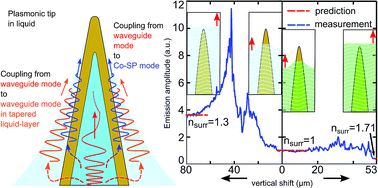Controlling the excitation of radially polarized conical plasmons in plasmonic tips in liquids†
Abstract
Having virtues from plasmons and scanning probe microscopy (SPM), plasmonic tips employ radially polarized conical plasmons and create hot-spots at their apexes. Plasmonic tips are tapered and fully metal-coated vortex fibers that have M-shaped refractive index profiles. Vortex fibers allow the radially polarized mode to propagate over a long distance with high modal purity. When the fiber mode reaches the tapered region, it resonantly excites the plasmon mode at a metal-dielectric outer interface. In this paper, we study the plasmonic tip's behavior in liquids both theoretically and experimentally. By adiabatically tapering the vortex fiber, the radially polarized mode gets confined from the fiber with a diameter of 115 μm down to the tapered part with a diameter of 1.42 μm as a waveguide mode. In this region, the plasmon mode gets excited thus reaches the apex with a diameter of 200 nm. Our calculations show that the plasmon coupling efficiency increases in liquids due to two competing processes: a significant increase of the interaction region and slight decrease of the penetration depth of fields in metal. By choosing a liquid that either allows or forbids the phase-matching, we demonstrate that the plasmon coupling efficiency can increase or vanish. Due to the wetting effect, a tapered liquid-layer forms over the tip like an additional waveguide and allows resonant coupling of fiber modes to the liquid layer.


 Please wait while we load your content...
Please wait while we load your content...